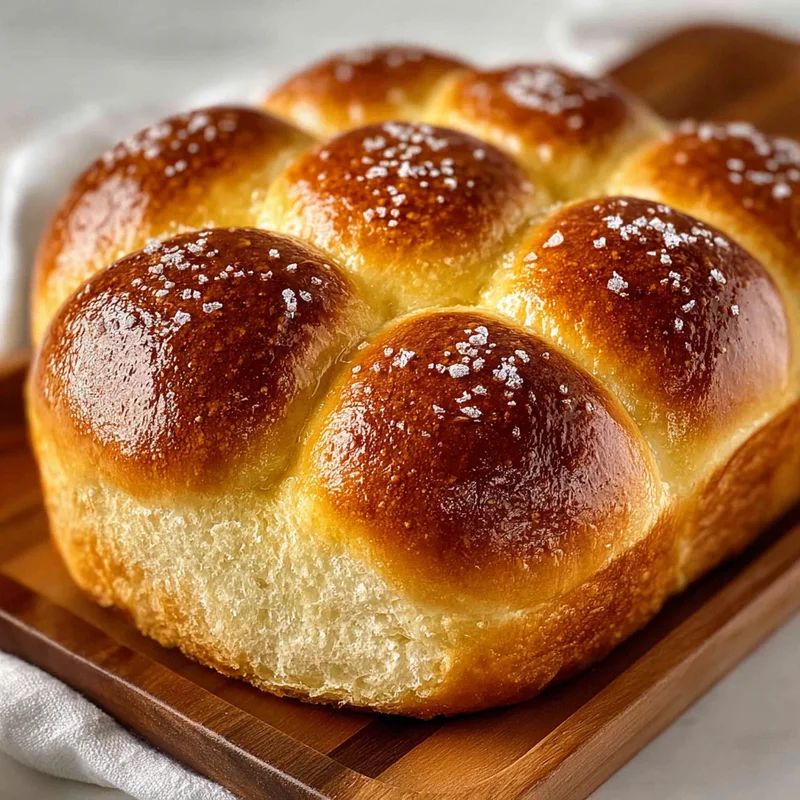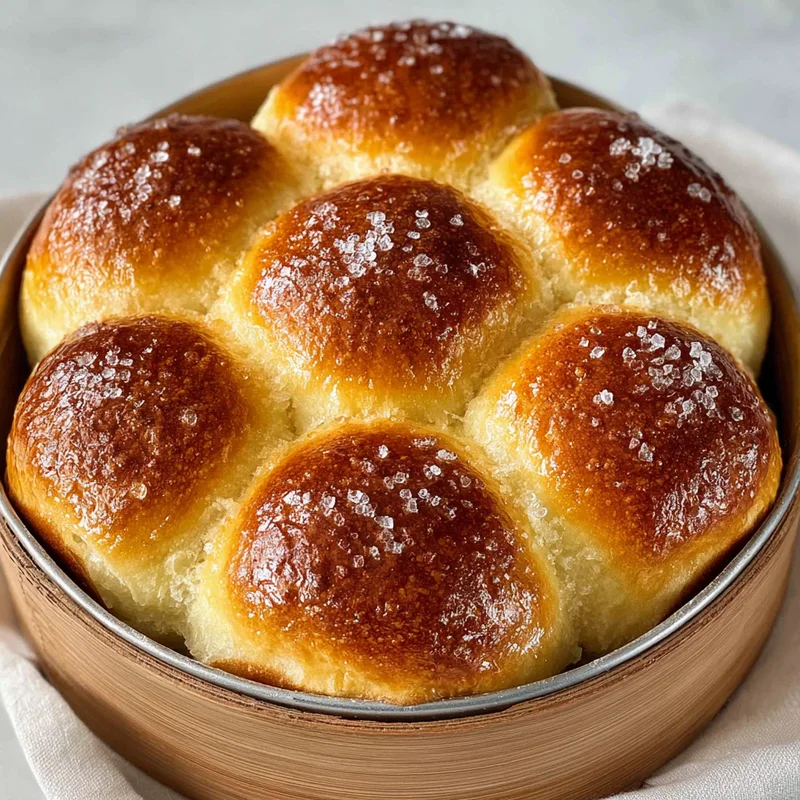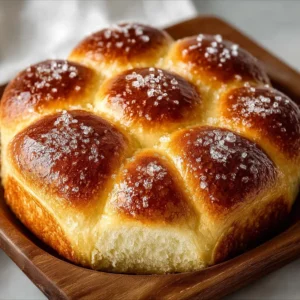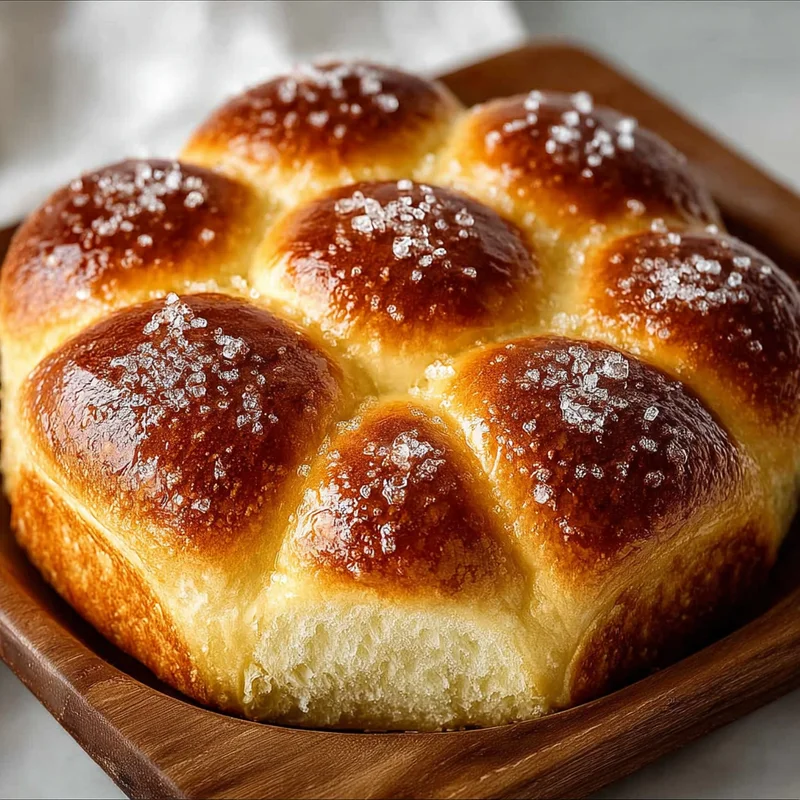Oh, friends! Do you remember the sheer joy of biting into a cloud-like piece of bread, so incredibly soft it almost melts in your mouth? For me, that sensation instantly transports me back to childhood, to cozy mornings and the comforting aroma of freshly baked goods wafting through the house. Today, I’m sharing a recipe that captures that magic: Japanese Milk Bread Rolls. These aren’t just any rolls; they are legendary for their unbelievably tender crumb and slightly sweet, milky flavor. And guess what? They’re much easier to make than you might think!
Why You’ll Love This Japanese Milk Bread Rolls Recipe
- Fast: While bread can sometimes feel like a long commitment, this recipe is surprisingly efficient.
- Easy: We’re breaking it down step-by-step, and with a little guidance, you’ll be a pro in no time.
- Giftable: Imagine the delight of giving a basket of these warm, fragrant rolls to friends and family! They make the most thoughtful homemade gift.
- Crowd-pleasing: From picky eaters to gourmet foodies, everyone falls in love with the irresistible texture and taste of Japanese Milk Bread.
Ingredients
Alright, let’s gather our ingredients! Don’t be intimidated by the list; each one plays a special role in creating that signature softness.
For the Yeast Mixture:
- 1 tablespoon active dry yeast: Make sure your yeast is fresh for a good rise!
- ¼ cup water, warmed (105-110°F): This is like a cozy bath for your yeast to wake it up.
For the Tangzhong Mixture:
This is our secret weapon for that amazing softness!
- 4 tablespoons whole milk: Adds richness and a lovely subtle sweetness.
- 2 tablespoons water: Works with the milk to create the paste.
- 2 tablespoons all-purpose flour: This is what creates the magical thickening agent.
For the Dough:
- 2 ½ cups (312.5 g) all-purpose flour: Our sturdy base.
- ½ cup (122.5 g) whole milk, room temperature: Room temperature milk blends beautifully into the dough.
- ¼ cup (50 g) granulated sugar: Just enough sweetness to make them irresistible.
- 1 teaspoon kosher salt: Balances the sweetness and enhances flavor.
- 2 large eggs, room temperature (divided): One whole egg for richness, and one yolk for extra tenderness!
- 3 tablespoons unsalted butter, softened: Make sure it’s soft, not melted, for easy incorporation.
- 1 tablespoon water: To help bring everything together.

How to Make It
Let’s get our hands a little floured and make some magic happen!
- Activate the Yeast: In a small bowl, combine the warmed water and active dry yeast. Give it a gentle stir and let it sit for about 5-10 minutes until it gets foamy. This means your yeast is alive and ready to go!
- Make the Tangzhong: While your yeast is waking up, let’s create our Tangzhong. In a small saucepan, whisk together the 4 tablespoons of milk, 2 tablespoons of water, and 2 tablespoons of flour. Cook over medium-low heat, whisking constantly, until it thickens into a paste. It might look a bit lumpy at first, but keep whisking! Once it’s smooth and thick, remove it from the heat and let it cool completely. This is crucial – you don’t want to kill your yeast!
- Combine Wet Ingredients: In a large mixing bowl (or the bowl of your stand mixer with the dough hook attached), combine the cooled Tangzhong mixture, the room temperature milk, the activated yeast mixture, one whole egg, and the egg yolk. Whisk it all together until it’s well combined.
- Add Dry Ingredients: Add the all-purpose flour, granulated sugar, and kosher salt to the wet ingredients.
- Mix the Dough: Start mixing everything together. If you’re using a stand mixer, mix on low speed until a shaggy dough forms. If you’re mixing by hand, use a sturdy spoon or spatula.
- Knead the Dough: Once the dough starts to come together, it’s time to knead! If using a stand mixer, increase the speed to medium-low and knead for about 8-10 minutes, or until the dough is smooth, elastic, and pulls away from the sides of the bowl. If kneading by hand, turn the dough out onto a lightly floured surface and knead for 10-15 minutes, pushing and folding until it’s beautifully smooth and elastic.
- Incorporate the Butter: Now for the butter! Add the softened butter, 1 tablespoon at a time, kneading after each addition until it’s fully incorporated. The dough might seem a bit messy at first, but keep kneading, and it will come back together, becoming even smoother and more elastic.
- First Rise (Bulk Fermentation): Lightly grease a clean bowl. Place the dough in the bowl, turning it to coat. Cover the bowl with plastic wrap or a damp kitchen towel and let it rise in a warm place for about 1 to 1.5 hours, or until doubled in size. I love to put my bowl in a slightly warm oven (turned off, of course!) – it’s a cozy spot for dough.
- Shape the Rolls: Once doubled, gently punch down the dough to release the air. Turn it out onto a lightly floured surface. Divide the dough into equal portions (I usually get 8-10 rolls from this recipe). You can shape them into balls or create the classic Japanese milk bread swirl by flattening each piece, rolling it up tightly, and then placing them seam-side down in a greased baking pan.
- Second Rise: Cover the shaped rolls loosely with plastic wrap or a damp towel and let them rise again in a warm place for about 45-60 minutes, or until they’re puffy and have nearly doubled in size.
- Egg Wash & Bake: Preheat your oven to 350°F (175°C). In a small bowl, whisk together the remaining egg white with the 1 tablespoon of water. Gently brush the tops of the rolls with this egg wash for a beautiful golden finish. Bake for 15-20 minutes, or until the rolls are golden brown and sound hollow when tapped on the bottom.
- Cool and Enjoy! Let the rolls cool in the pan for a few minutes before transferring them to a wire rack to cool completely. But honestly, who can wait? They are heavenly when still a little warm!
Substitutions & Additions
Feeling creative? Here are some ways to make these rolls your own!
- Milk: While whole milk is recommended for the best flavor and texture, you can use 2% milk if that’s what you have.
- Flour: For a slightly nuttier flavor and added protein, you could try substituting a small portion (about ¼ cup) of the all-purpose flour with bread flour.
- Sweetness: If you prefer a less sweet roll, you can reduce the sugar slightly.
- Add-ins: For a sweet twist, try adding a tablespoon of honey to the Tangzhong mixture or a sprinkle of cinnamon and sugar inside the rolled dough before shaping.
- Richness: For an even richer dough, you could use only milk instead of the milk and water combination in the Tangzhong.
Tips for Success
A few little secrets to guarantee perfect rolls every time!
- Don’t Rush the Rise: Patience is key! Make sure your dough has doubled in size during both rises for that signature fluffiness.
- Temperature is Everything: Ensure your water for the yeast is the right temperature – too hot and it kills the yeast, too cold and it won’t activate.
- Kneading is Crucial: Properly kneading develops the gluten, which is what gives the bread its structure and chewy-soft texture.
- Prep Ahead: You can make the Tangzhong mixture a day in advance and store it in the refrigerator. Just let it come to room temperature before adding it to the dough.
- Oven Hot Spot: If your oven tends to have hot spots, you might want to rotate your baking pan halfway through the baking time.

How to Store It
These rolls are best enjoyed fresh, but they store beautifully for a few days!
- Once completely cooled, store the Japanese Milk Bread Rolls in an airtight container or a zip-top bag at room temperature for up to 3 days.
- For longer storage, you can freeze them! Wrap them tightly in plastic wrap and then place them in a freezer-safe bag for up to 2 months. To reheat, simply thaw at room temperature or warm them gently in the oven.
FAQs
Q: Can I make Japanese Milk Bread Rolls without a stand mixer?
Absolutely! While a stand mixer makes kneading easier, you can definitely achieve the same results by hand. Just be prepared for a good arm workout, but the delicious outcome will be well worth it!
Q: Why are my rolls not fluffy?
There are a few common culprits: your yeast might not have been active, the dough wasn’t kneaded enough to develop gluten, or it didn’t rise sufficiently. Double-check your yeast’s expiration date and make sure you’re giving the dough enough time and warmth for its rises.
Q: Can I use milk powder instead of milk?
While you could potentially use milk powder reconstituted with water, the liquid milk in this recipe contributes to the dough’s tenderness and richness in a way that milk powder alone might not replicate. It’s best to stick to liquid milk for this particular recipe.
Q: How long does the Tangzhong mixture last?
The Tangzhong mixture can be made ahead and stored in an airtight container in the refrigerator for up to 2 days. Just be sure to bring it back to room temperature before using it in the dough.

Japanese Milk Bread Rolls
Equipment
- Small bowl for activating yeast
- Small saucepan for making tangzhong
- Whisk for tangzhong and mixing
- Large mixing bowl or stand mixer bowl
- stand mixer with dough hook optional, for kneading
- Spatula for mixing by hand
- Plastic wrap for covering dough
- damp kitchen towel for covering dough
- Baking pan greased, for shaping rolls
- Pastry brush for egg wash
- Wire rack for cooling
Ingredients
Yeast Mixture
- 1 tablespoon active dry yeast Make sure your yeast is fresh for a good rise!
- 0.25 cup water warmed (105-110°F)
Tangzhong Mixture
- 4 tablespoons whole milk Adds richness and a lovely subtle sweetness.
- 2 tablespoons water Works with the milk to create the paste.
- 2 tablespoons all-purpose flour This is what creates the magical thickening agent.
Dough
- 2.5 cups all-purpose flour Our sturdy base.
- 0.5 cup whole milk room temperature
- 0.25 cup granulated sugar Just enough sweetness to make them irresistible.
- 1 teaspoon kosher salt Balances the sweetness and enhances flavor.
- 2 large eggs room temperature (divided: one whole egg for richness, and one yolk for extra tenderness!)
- 3 tablespoons unsalted butter softened
- 1 tablespoon water To help bring everything together.
Egg Wash
- 1 tablespoon water for egg wash
Instructions
- Activate the Yeast: In a small bowl, combine the warmed water and active dry yeast. Give it a gentle stir and let it sit for about 5-10 minutes until it gets foamy.
- Make the Tangzhong: In a small saucepan, whisk together the 4 tablespoons of milk, 2 tablespoons of water, and 2 tablespoons of flour. Cook over medium-low heat, whisking constantly, until it thickens into a paste. Remove from heat and let it cool completely.
- Combine Wet Ingredients: In a large mixing bowl, combine the cooled Tangzhong mixture, the room temperature milk, the activated yeast mixture, one whole egg, and the egg yolk. Whisk until well combined.
- Add Dry Ingredients: Add the all-purpose flour, granulated sugar, and kosher salt to the wet ingredients.
- Mix the Dough: Mix everything together until a shaggy dough forms. If using a stand mixer, mix on low speed. If mixing by hand, use a sturdy spoon or spatula.
- Knead the Dough: Knead for 8-10 minutes in a stand mixer on medium-low speed, or 10-15 minutes by hand on a lightly floured surface, until the dough is smooth, elastic, and pulls away from the sides of the bowl.
- Incorporate the Butter: Add the softened butter, 1 tablespoon at a time, kneading after each addition until fully incorporated. Continue kneading until the dough is even smoother and more elastic.
- First Rise: Lightly grease a clean bowl. Place the dough in the bowl, turning to coat. Cover and let it rise in a warm place for 1 to 1.5 hours, or until doubled in size.
- Shape the Rolls: Gently punch down the dough. Turn it out onto a lightly floured surface and divide into 8-10 equal portions. Shape them into balls or create the classic swirl by flattening each piece, rolling it up tightly, and placing seam-side down in a greased baking pan.
- Second Rise: Cover the shaped rolls loosely and let them rise in a warm place for about 45-60 minutes, or until puffy and nearly doubled in size.
- Egg Wash & Bake: Preheat oven to 350°F (175°C). Whisk together the remaining egg white and 1 tablespoon of water. Gently brush the tops of the rolls. Bake for 15-20 minutes, or until golden brown and sound hollow when tapped.
- Cool and Enjoy: Let the rolls cool in the pan for a few minutes before transferring them to a wire rack to cool completely. Enjoy warm!

